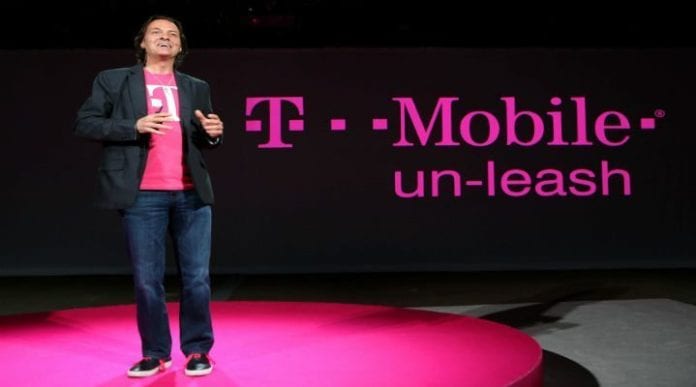T-Mobile US has laid claim to being the domestic market’s largest prepaid wireless provider, stating that during the second quarter it surpassed the prepaid customer bases of its larger rival Sprint.
At the end of the second quarter, T-Mobile US said it had 15.64 million prepaid customers on its network, having added 102,000 branded prepaid customers to its network during the quarter. That growth was down sequentially from the first quarter of the year, but a significant turnaround from the direct prepaid customer losses T-Mobile US reported for the second quarter of 2013.
T-Mobile US’ prepaid operations received a jolt last year following the acquisition of MetroPCS, which brought nearly 10 million prepaid customers to T-Mobile US and continues to be a branded effort for the carrier. T-Mobile US claims the MetroPCS brand has added more than 1.2 million customers since last year, boosted by the expansion of coverage into T-Mobile US’ network. T-Mobile US’ branded prepaid customer base made up 39% of the carrier’s total branded customer base of 40.2 million customers.
While T-Mobile US showed continued prepaid growth, Sprint lost 542,000 direct prepaid customers during the second quarter, dropping its total direct prepaid base to 15.19 million, according to T-Mobile US. Sprint’s direct prepaid efforts include the Sprint Prepaid brand, Virgin Mobile USA, Boost Mobile and Assurance Wireless.
T-Mobile US claims an even larger lead over the industry’s two largest operators, noting AT&T Mobility had just 11.34 million prepaid customers at the end of the second quarter, while Verizon Wireless counted 6.04 million direct prepaid subscribers.
Prepaid remains hotly contested
The prepaid space remains a hotly contested market as traditional postpaid channels have reached near saturation. At the end of the second quarter, T-Mobile US added Apple’s iPhone devices to its prepaid channels as well as expanded the prepaid service’s distribution. Late last month, Sprint’s Virgin Mobile USA division announced plans for customized rate plans tapping into a software agreement with ItsOn. That move followed previous pricing moves for its PayLo offering and a new distribution agreement with Walmart.
AT&T Mobility earlier this year expanded its prepaid presence following the close of its acquisition of Leap Wireless and resulting re-launch of the Cricket brand. That re-launch included folding in AT&T Mobility’s Aio Wireless offering, though its GoPhone brand remains available as a stand-alone product. However, AT&T Mobility’s direct prepaid business has yet to find its footing as the company said it lost 405,000 customers from that segment during the second quarter. The carrier said the defections were tied to increased customer churn related to the Cricket re-launch.
Verizon Wireless, on the other hand, has barely paid lip-service to its branded prepaid efforts. That lack of effort was highlighted by the 14,000 direct prepaid net losses posted during the second quarter, which offset a gain of 10,000 customers during the first quarter of this year. The carrier only recently began allowing direct prepaid customers access to its LTE network, which followed on the heels of an update to its AllSet prepaid plans earlier this year.
The prepaid segment remains a balancing act for carriers as no-contract customers typically spend less per month and generate higher churn rates. T-Mobile US reported $37.16 in branded prepaid average revenue per user for the second quarter, which was $12.16 lower than its branded postpaid result. Though it should be noted that the carrier’s prepaid ARPU increased 6.8% year-over-year, while its postpaid ARPU dropped 8.7%. Customer churn results showed a similar discrepancy, with 4.5% prepaid churn during the second quarter, while postpaid churn was just 1.5%.
Legere predicts No. 3 by year end
And, in a move to further taunt its rumored one-time suitor, T-Mobile US CEO John Legere said he expects to surpass Sprint in total customers by the end of this year. T-Mobile US ended the second quarter with more than 50.5 million connections on its network, having added nearly 4 million through the first half of the year. Sprint, on the other hand, has lost nearly 800,000 customers through the first half of the year, ending the second quarter with 54.5 million total connections on its network.
Following its strong Q2 results, T-Mobile US increased its full-year postpaid customer growth guidance to as high as 3.5 million net customer additions, which suggests it expects to add around 1.3 million new postpaid customers by year end. Conversely, Sprint has just replaced long-time CEO Dan Hesse with former Brightstar founder and CEO Marcello Claure and squashed rumored plans to attempt an acquisition of T-Mobile US. That sort of short-term uncertainty could provide T-Mobile US with the boost it needs to overcome its rival.
Bored? Why not follow me on Twitter?

